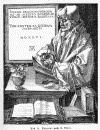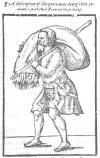|
16th century England – a snapshot.
At the turn of the sixteenth century the church of Rome was possibly at its most powerful, but contrastingly at a very low ebb in the common man`s perception. At the Fifth Lateran Council in 1512 – 1517 the remark was passed “Now nobody contradicts, no one opposes” and ended with complacent self congratulation. The storm was about to break later that year with Martin Luther`s protest and the nailing of his Ninety Five Theses to the church door in Wittenburg.
But it was not true that no one opposed, for even within the church there had been movement to curb excesses through the Devoti Moderna ( the modern way of serving God) which was a spiritual revival with strong emphasise on both personal devotion and social involvement, especially in education. The movement developed in northern Europe and became `The Brethren of the Common Life` and Augustinian canons with a constitution approved by Pope Boniface IX in 1395. As an order they particularly focussed on education , taught in local schools and involved themselves in every aspect of book production. One of their order was Thomas Haemerken, better known as Thomas a Kempis and author of the book Imitation of Christ regarded as second only to the Bible. By mid century it was widely read throughout western Europe, and has run to several thousand editions since first printed at Augsburg in 1471. Of the same Order came was widely read throughout western Europe, and has run to several thousand editions since first printed at Augsburg in 1471. Of the same Order came
Desidirius Erasmus (1467-1536) who brought his enlightened thought to England (first in 1499-1500) where he was a close confident of Dean Colet of St Pauls, and the catholic Sir Thomas More. He became also a friend of the young Henry, Duke of York, who had been earmarked for the post of Archbishop of Canterbury when he grew up.
The accession of Henry VII in 1485 was important not least because he united the Houses of York and Lancaster through his marriage to Elizabeth of York. A condition of the marriage was to dispose of the last Plantagenet claimant the Earl of Warwick, a prisoner in the Tower. Warwick was executed without further ado. On a personal front Henry VII, in contrast to his predecessors, was a good steward (some say avaricious) and assiduously gathered in vast treasure. This meant that he was not dependent on others, including the church, to finance any foreign ventures. In selecting a wife for his eldest son, Prince Arthur, he was similarly careful to ensure that she would have a good dowry. In this respect he settled on Catharine, princess of Arragon, daughter of Ferdinand and Isabella of Castile, who (coincidentally) came with a dowry of 200,000 gold ducats. But this happy union did not last – married on 14 November Prince Arthur suddenly died the following 2 April . The immediate concern of Henry VII was whether he should return the dowry but resolved the matter by proposing that Catharine marry the young prince Henry. For this a papal dispensation was required and duly delivered by Pope Julius II in December 1503; the couple were thus betrothed but not yet married because of Prince Henry`s youth. There were some mutterings by the people who did not approve of the circumstances of the marriage and at one point, 27 June 1505, Henry in the presence of the Bishop of Winchester and other counsellors said that he would never marry Catharine.
As with the execution of Warwick, Henry VII recognised when it was expedient to take life and had little scruples with the burning a few heretics according to law. Among the martyrs was an eighty year old Joan Boughton who held Wickcliffian opinions. The
 appearance of sinners at St Pauls during service bearing faggots on their shoulder (indicating their fate if they did not abjure their heretical views) became quite common. Elsewhere sinners bearing faggots were found in Amersham, in 1506, when William Tylsworth was burned – his daughter Joan Clerk being compelled to light the fire that consumed him. In the same event some twenty three persons associated with him were made to do penance by bearing faggots in nearby towns of Buckingham and Aylesbury. The men were also burned in the cheek. Several more burnings took place in the locality in the next few years. appearance of sinners at St Pauls during service bearing faggots on their shoulder (indicating their fate if they did not abjure their heretical views) became quite common. Elsewhere sinners bearing faggots were found in Amersham, in 1506, when William Tylsworth was burned – his daughter Joan Clerk being compelled to light the fire that consumed him. In the same event some twenty three persons associated with him were made to do penance by bearing faggots in nearby towns of Buckingham and Aylesbury. The men were also burned in the cheek. Several more burnings took place in the locality in the next few years.
In 1506 Henry VII sent representatives to Pope Julius II yielding his obedience to Rome. About the same time Louis XII called his parliament to determine if obedience was due to Rome when the Pope`s
military forces had invaded his country. They declared no obedience was due, thus Pope Julius was at war with France and had Henry as an ally. Henry VII died in May 1509 and Henry VIII was proclaimed King. Some seven weeks after his father`s death Henry relented on his earlier statement about marrying Catharine, and on 11 June 1509 they were privately married. The King and Queen were crowned on the 23rd of June with much pomp and ceremony.
Henry VIII already had a wise head on his shoulders and took pains to appoint able ministers, including Warham, Archbishop of Canterbury as Lord Chancellor. Of Warham it can be said that he was a man of great capacity and worked extremely hard at all he did. Henry, the comely young man now king, was lauded by all and sundry, especially among the educated, who at last had a king, fluent in several languages who spoke and wrote in French, German and Spanish and a friend of the great Erasmus. At this time Erasmus was in Rome attending the Pope – Julius II, who was not apparently bothered whether Erasmus stayed or not – he preferred to go hunting and enjoyed his food, rather than learned discussion. Erasmus was present when three emissaries arrived, among them was a young Thomas Cromwell who as a sop to Julius had brought some English jelly which titillated the Pope`s palate and thereby facilitated the renewal of two `pardons` previously granted to the town of Boston (Lincolnshire).
In the ensuing arguements with Rome over the divorce of Henry and Catharine of Arragon new faces appeared at Court, including Thomas Cromwell – the man destined to separate England from Rome and, as vice regent to Henry, oversee the of the dissolution of the monasteries. He pushed through Henry`s Injunctions that gradually did away with the practices of the church of Rome. But before this could happen there was the crucial advice from Thomas Cranmer who succeeded Warham as Archbishop of Canterbury in 1532, that encapsulates the Protestant Reformation in England -“The word of God is above the church” .
When the break with Rome finally came it was not as clean as the Reformation in Scotland. Henry allegedly remained `catholic` all his life and this may explain why he favoured both sides at various times. Certainly his marital machinations, and the foreign policy issues with which they ran in tandem, did not help matters. With one eye on the shifting alliances in Europe, Henry was easily diverted from his purpose as the new Supreme Head of the Church of England. It was a huge task to change the beliefs and ways of a nation; but the Reformation was faced by a strong resistance led by the likes of Stephen Gardiner, Bishop of Winchester. In consequence there were very considerable pressures, as well as uncertainties, among the populace with rebellions in Lincolnshire and Yorkshire. Legislation such as the Act of Six Articles did not help relations with the people. Thus there was a continuing stream of martyrs – hundreds of people being taken and burnt for heresy more or less at the whim of anyone who was inclined to complain about the most fatuous matters. The confusion was exacerbated by quite a few friars and monks also being executed (usually hung drawn and quartered ) for treason by virtue of refusing to accept Henry as Head of the church. On
one occasion in Smithfield, three Protestants were burnt for heresy while three
Catholics were executed at the same time for treason.
Cranmer exercised great influence as godfather, councillor and tutor of the young Edward VI whose short reign saw a number of critical changes and re emphasis of a protestant faith. Cranmer suffered martyrdom at the stake in 1556, when “Bloody” Mary came to the throne. Although Mary persecuted the Protestants and declared for Catholicism, her sister and successor to the throne, Elizabeth I, consolidated the Protestant Church of England. But even under Elizabeth there was no toleration, and the rules for conformity with the Church of England were strict with penalties for clergy and public who did not comply.
In Scotland John Knox visited and made contact with the Lords of the Congregation before returning to his flock in Geneva for a while, and to his studies with John Calvin. He returned permanently in 1559 to urge through the establishment of a Presbyterian church in 1560. England turned to Elizabeth I (r1558-1603) who re-enacted the acts of Henry VIII and on the face of it sealed the end of Catholicism as the official faith in England. This a provided a bulwark for the Protestant Reformation in Scotland. But even under Elizabeth I there was still a mixture of old and new practices as well as many former priests.
At much the same time as the Lords of the Congregation and John Knox were pushing ahead with their reforms in Scotland, so in England was there a movement to bring Calvinist ways into the Church of England. The restoration of the Common Prayer Book of Edward VI was duly ratified and Protestantism restored as the official faith of England. By 1572 in the reign of Elizabeth I, the Calvinist – Puritans were presenting their First Admonition to the English Parliament and for a while had high hopes of achieving reform, and led to the first presbytery being set up in England. In 1581 the Separatist movement under Robert Browne and Robert Harrison set up their independent congregation in Norwich based on a church covenant. This was the beginning of the Independent or Congregational movement to which Oliver Cromwell later belonged. Before his time however, the Independents were severely repressed and forced to go to Holland for a while. Elizabeth I declined the reforms presented by the Puritans, as did her successor James VI of Scotland in 1603. In that year the Puritans made their Millenary Petition to James VI/I which gave rise to the Hampton Court Conference of 1604.
The emphasis of Reform changed again under the Stuart kings, but this was in respect of their personal `Divine Right of Kings` philosophy, and the nature of the now firmly established Protestant Church of England. Their claimed supremacy in all things demanded that the official church was that
of their choice
– that is episcopal, which prompted
discrimination and eventually persecution of all non conformists and dissenters, particularly the Presbyterian
Covenanters of Scotland. There were however, still concerns at restoration of a Catholic Church under Charles II and his brother James II that were not expunged until the `Glorious Revolution` in 1688 and the arrival on the throne of
protestants William III and Mary.
18/07/2011
|